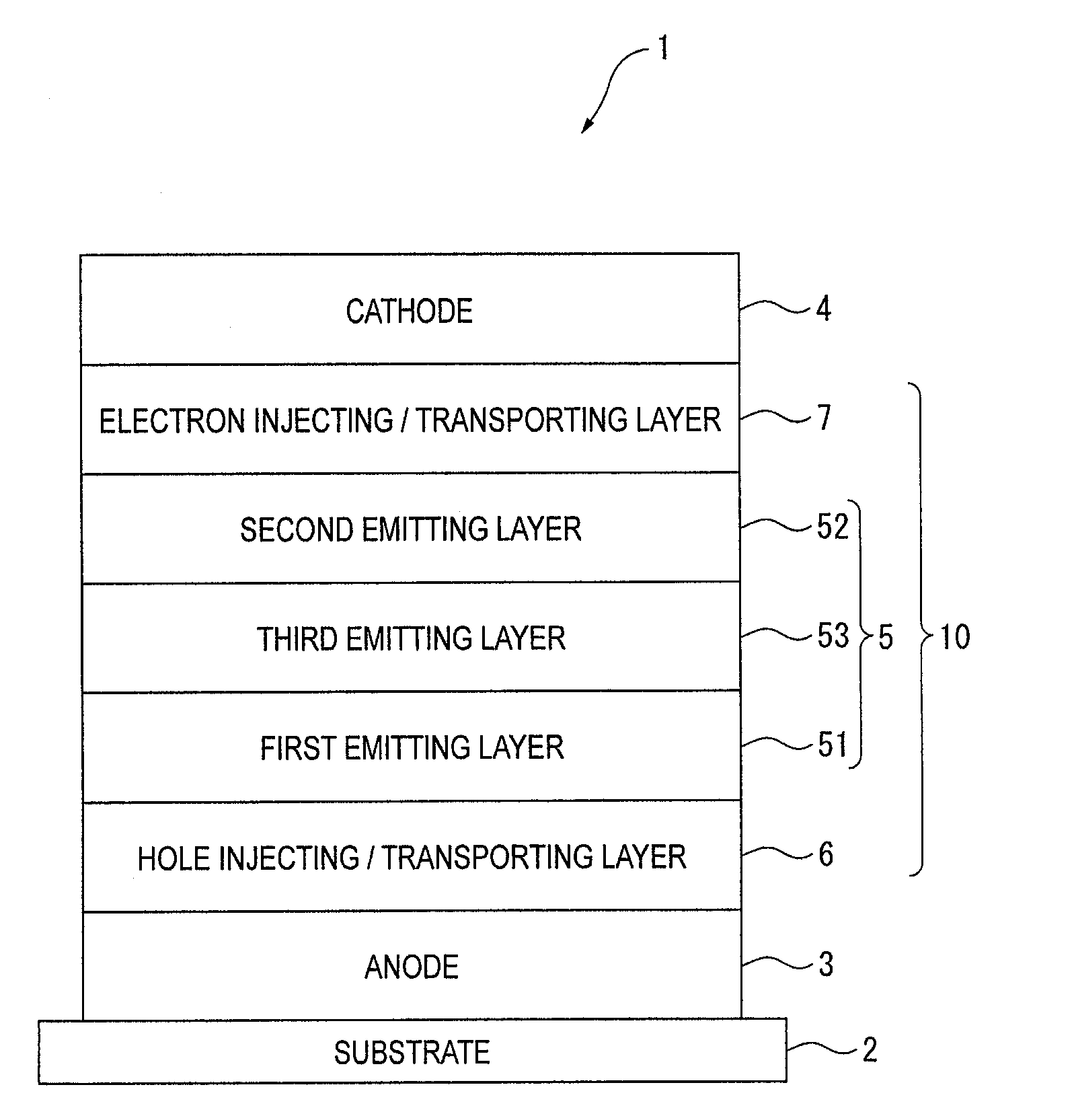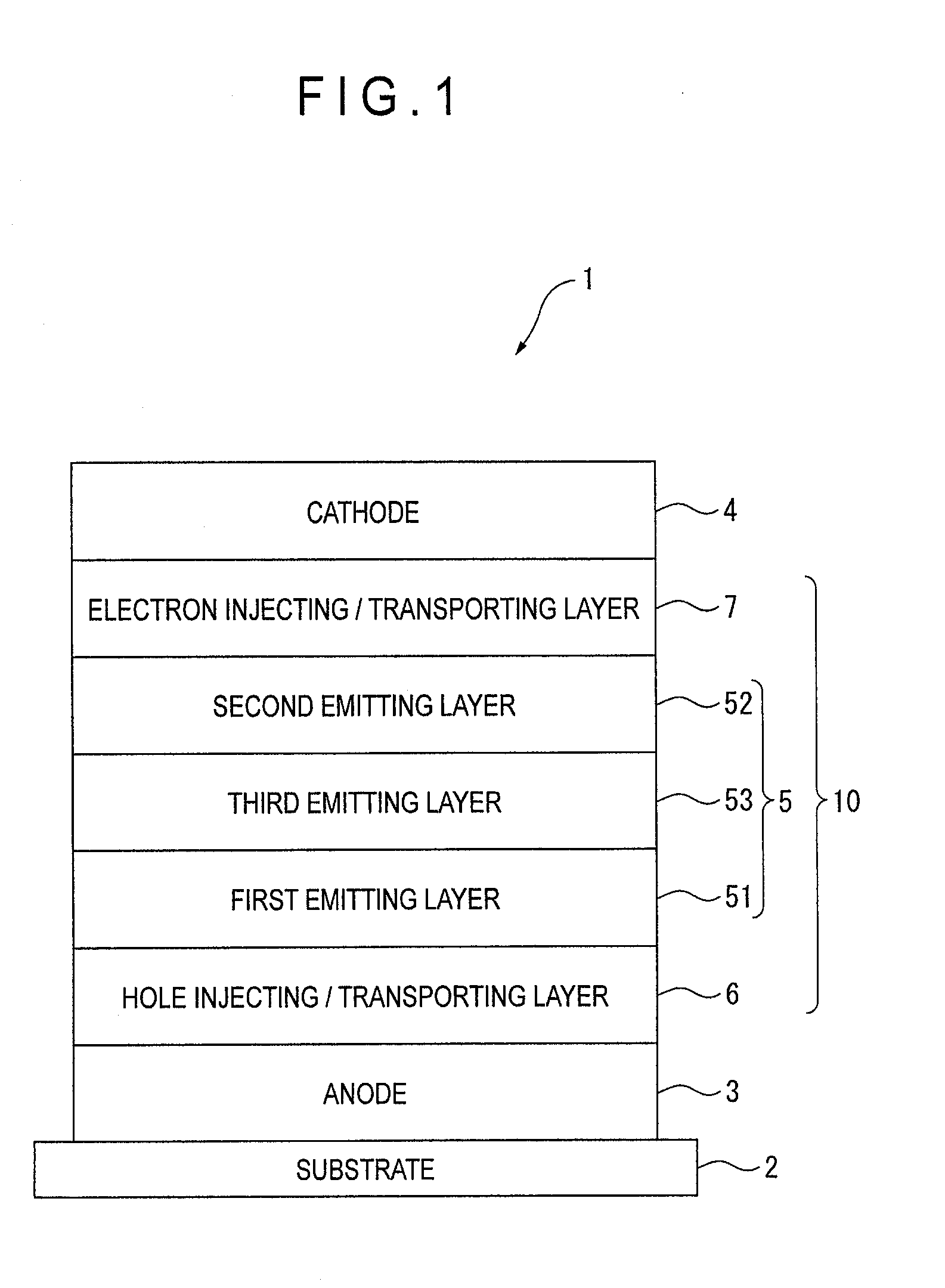Organic electroluminescence device
a technology of electroluminescence device and organic material, which is applied in the direction of electroluminescent light source, chemistry apparatus and process, and composition of light source, can solve the problems of limited examples that achieved a practical life and efficiency, material unadjustable deformation, and decreased luminance, and achieve excellent color stability
- Summary
- Abstract
- Description
- Claims
- Application Information
AI Technical Summary
Benefits of technology
Problems solved by technology
Method used
Image
Examples
example 1
[0303]A glass substrate (size: 25 mm×75 mm×1.1 mm thick, manufactured by Geomatec Co., Ltd.) having an ITO transparent electrode (anode) was ultrasonic-cleaned in isopropyl alcohol for five minutes, and then UV / ozone-cleaned for 30 minutes. After the glass substrate having the transparent electrode line was cleaned, the glass substrate was mounted on a substrate holder of a vacuum deposition apparatus, so that a 10-nm thick film of a compound HT1 was initially formed at 1 Å / s as a hole injecting layer on a surface of the glass substrate where the transparent electrode line was provided so as to cover the transparent electrode.
[0304]On this film, a 10-nm thick film of a compound HT2 was formed at 1 Å / s as a hole transporting layer.
[0305]Further on this film of the compound HT2, a 3-nm thick film of a compound L1 and compound D1 was formed as a first emitting layer with a thickness ratio of the compound L1 to D1 being 2.85:0.15. Film-forming rates were respectively 1 Å / s and 0.052 Å / s...
example 2
[0311]Except that the compound L3 was used as the second emitting layer in place of the compound L1, the organic EL device according to Example 2 was manufactured in the same manner as Example 1.
example 3
[0312]A glass substrate (size: 25 mm×75 mm×1.1 mm thick, manufactured by Geomatec Co., Ltd.) having an ITO transparent electrode (anode) was ultrasonic-cleaned in isopropyl alcohol for five minutes, and then UV / ozone-cleaned for 30 minutes. After the glass substrate having the transparent electrode line was cleaned, the glass substrate was mounted on a substrate holder of a vacuum deposition apparatus, so that 10-nm thick film of the compound HT1 was initially formed at 1 Å / s as a hole injecting layer on a surface of the glass substrate where the transparent electrode line was provided so as to cover the transparent electrode.
[0313]On this film, a 10-nm thick film of the compound HT2 was formed at 1 Å / s as a hole transporting layer.
[0314]Further on this film of the compound HT2, a 3-nm thick film of the compound L1 and compound D1 was formed as a first emitting layer with a thickness ratio of the compound L1 to D1 being 2.85:0.15. Film-forming rates were respectively 1 Å / s and 0.052...
PUM
| Property | Measurement | Unit |
|---|---|---|
| triplet energy | aaaaa | aaaaa |
| work function | aaaaa | aaaaa |
| thickness | aaaaa | aaaaa |
Abstract
Description
Claims
Application Information
 Login to View More
Login to View More - R&D
- Intellectual Property
- Life Sciences
- Materials
- Tech Scout
- Unparalleled Data Quality
- Higher Quality Content
- 60% Fewer Hallucinations
Browse by: Latest US Patents, China's latest patents, Technical Efficacy Thesaurus, Application Domain, Technology Topic, Popular Technical Reports.
© 2025 PatSnap. All rights reserved.Legal|Privacy policy|Modern Slavery Act Transparency Statement|Sitemap|About US| Contact US: help@patsnap.com



